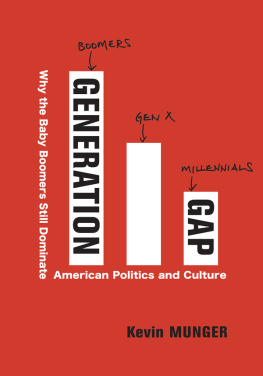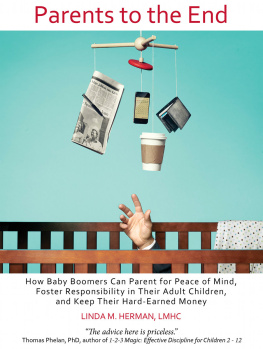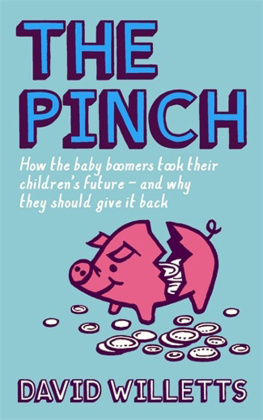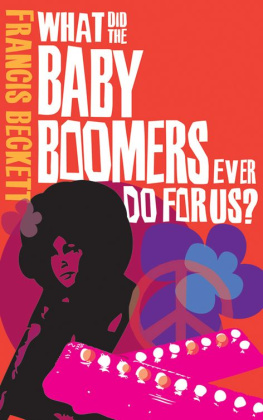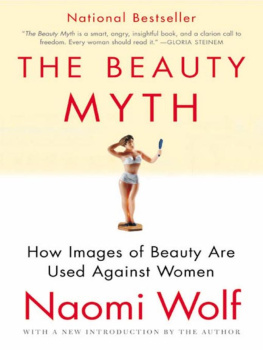BABY BOOMERS, AGE, AND BEAUTY
This book offers an important contribution to the discussion on our approach to age and ageing. The author makes us understand that it is both the universal and the particular that determine how we behold beauty, and how these perceptions are generationally shaped.Prof Dr Roberta Maierhofer, University of Graz, Austria
Fluently written and sensitive to context, nuance, and the humor of her aging respondents, Woodsprings book gives a lively tour of our disparate responses to the common urge to remain forever young, in a generation that lives longer than any before. She shows how masculinities, femininities, and gendered ideals of beauty shift with new divisions of labor, as age brings greater self-awareness of the limits of roles of the past. This book weaves into that analysis a rich array of insights from studies of art, taste, psychology, history, sociology, and feminist scholarship from many disciplines.Prof Neal M. King, Virginia Tech, College of Liberal Arts and Human Sciences, USA
In the context of an ageing population, Woodspring reminds us of the tyranny of the omnipresent stereotypes of what successful (ie, glamourous) ageing looks like. This book is a timely reminder that the perspectives of older people are also of crucial value to current debates in this field and should no longer be ignored.Emerita Prof Nichola Rumsey OBE, UWE, UK
BABY BOOMERS, AGE, AND BEAUTY
BY
NAOMI WOODSPRING
University of the West of England, Bristol, UK
United Kingdom North America Japan India Malaysia China
Emerald Publishing Limited
Howard House, Wagon Lane, Bingley BD16 1WA, UK
First edition 2018
2018 Naomi Woodspring.
Published under exclusive licence.
Reprints and permissions service
Contact: permissions@emeraldinsight.com
No part of this book may be reproduced, stored in a retrieval system, transmitted in any form or by any means electronic, mechanical, photocopying, recording or otherwise without either the prior written permission of the publisher or a licence permitting restricted copying issued in the UK by The Copyright Licensing Agency and in the USA by The Copyright Clearance Center. Any opinions expressed in the chapters are those of the authors. Whilst Emerald makes every effort to ensure the quality and accuracy of its content, Emerald makes no representation implied or otherwise, as to the chapters suitability and application and disclaims any warranties, express or implied, to their use.
British Library Cataloguing in Publication Data
A catalogue record for this book is available from the British Library
ISBN: 978-1-78754-236-5 (Print)
ISBN: 978-1-78743-824-8 (Online)
ISBN: 978-1-78743-990-0 (Epub)
In memory of Nick Shipton
You taught me so much about beauty
CONTENTS
LIST OF IMAGES
Frontispiece |
Chapter 2 |
Chapter 7 |
Chapter 8 |
ABOUT THE AUTHOR
Naomi Woodspring is a Visiting Research Fellow, University of the West of England, UK. Prior to returning to university as a late life learner, she had her own consulting firm working with non-profit agencies and for-profit businesses seeking sustainable solutions to organizational and community challenges. She has also worked as a psychotherapist in a wide variety of settings from managing a community prison project to Native American communities.
ACKNOWLEDGMENTS
The project would not have materialized without the support of friends, family, and colleagues. There are so many people who have had a hand in making this book happen listening, questioning, pointing me in directions I would never have thought of and more. I want to thank Robin Means for being there at a very difficult time this book would not have happened without his encouragement and help. Thank you, Jane Powell for stepping in and championing the work, Margaret Page for being a good and true friend, smart, critical, and just the best, Barbara Walzer, for of all the reminders, our shared history/friendship, and proof reading. Big thanks to Jessa Fairbrother for the images, photography inspiration, and for giving me some central guiding thoughts as I considered cameras, photographs, and representation. I am indebted to Josephine Dolan for questioning and critiquing, and fearlessly holding a vision of another kind of world. I am deeply grateful to the people who stepped forward to be interviewed and who gave so generously of their time and thoughts.

Image 1. Roman Egyptian funerary portrait.
Source: British Museum.Notes: (AD 14060; tempera on wood) Roman Egyptian funerary portraiture depicted people as they appear. Her face speaks of a lifetime of experience. The artist captured an intelligence in her eyes that must have been full of life. Are the lines between her brows from worry or a long habit of thought/contemplation? Of course, we see her through our contemporary eyes and we can only imagine her presence 2000 years ago.
CHAPTER 1
INTRODUCTION
Naomi Woodspring
PROLOGUE
My dinner companion looked up from her plate and questioned why I was researching and writing a book on aging and beauty. Im just aging. I dont think much about it, she said in a challenging tone. She went on to declare that she never thought about her appearance and rarely looked in the mirror she preferred to look and age naturally. There is much embedded in this statement, choice, class, morality, history, technology, and vanity are among its riches. Despite my companions declaration, her hair was obviously well cut and styled with care and her face bore all the marks of being well looked after. This book is an exploration of those issues as expressed through our faces, or, from the neck up. How we age, our imaginings about who we are and how we look, how we present ourselves, and beauty are addressed in these chapters. These ideas are shaped by the culture we live in. Our notions about beauty and appearance are both universal and particular. There is always an interaction between our seemingly unique selves and our culture and society in both obvious and subtle ways. My dinner companions declaration was very much of her time and place.
INTRODUCTION
I am silver and exact. I have no preconceptions.
Whatever I see I swallow immediately
Just as it is, unmisted by love or dislike.
I am not cruel, only truthful. (Plath, p. 173)
Suddenly they could recognize themselves. They were shocked some ducked their heads and turned away, came back for another look, ducked away again. Eventually they could hold their gaze on the picture, mesmerized, trembling with tension. Some slipped away, photo clutched to their chest, to find a private place for closer inspection .These people were confronting their visual image for the first time, and were stunned not only by its novelty, but also by the potency of such an icon a representation of themselves that perhaps carried the power of their soul; or essence, their deepest identity. (A description of the indigenous Papua, New Guinea tribespeople seeing their own faces for the first time. The Polaroid photos were taken by anthropologist, Edmund Carpenter. From Bates & Cleese, 2001, p. 53)





